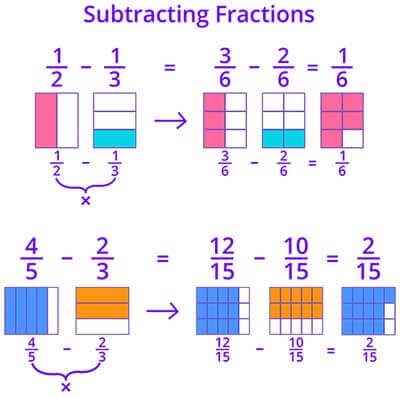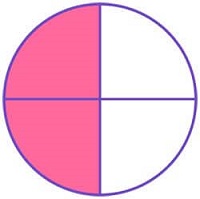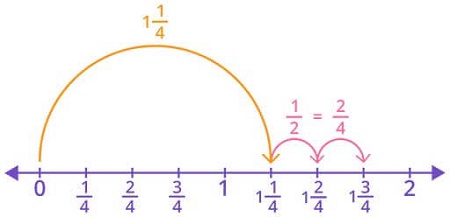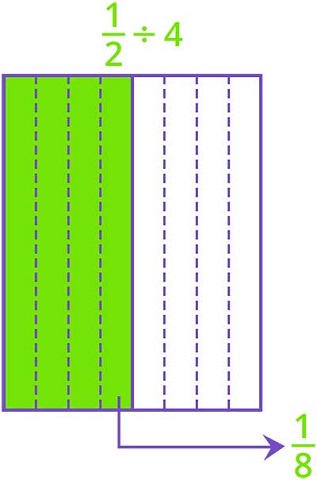CONTENT TYPE
SUBJECT
- Number Sense (17)
- Addition (8)
- Multiplication (32)
- Division (38)
-
Fractions
(73)
- Fractions Operations (68)
- Decimals (116)
- Read And Write Decimals (31)
-
Compare Decimals
(22)
-
Order Decimals
(10)
- Round Decimals (12)
-
Convert Decimals To Fractions
(5)
- Decimal Operations (40)
- Geometry (32)
- Measurement (24)
- Algebra (23)
- Word Problems (18)
Fractions Operations Games
View all 68 games-
VIEW DETAILS
 Add Mixed Numbers
Add Mixed NumbersFinding the Sum of Mixed Numbers Game
Help your child master the art of adding mixed numbers with this exciting math game. Through a series of well-crafted problems, kids will practice adding fractions without using models, making learning fun and effective. Perfect for those looking to improve their fraction skills, this game turns practice into an engaging adventure. Get started today!
-
VIEW DETAILS
 Subtract Fractions
Subtract FractionsEstimating the Difference Using Number Line Game
In this exciting game, kids will learn to estimate the difference between unlike fractions using a number line. By practicing subtraction of fractions in a fun way, your child will gain confidence and improve their math skills. This engaging activity is perfect for understanding fractions better and making learning enjoyable. Let your child explore subtraction with ease and have fun while mastering fractions!
-
VIEW DETAILS
 Subtract Mixed Numbers
Subtract Mixed NumbersCompleting the Mixed Numbers Subtraction Game
In this fun game, fifth graders tackle subtraction of mixed numbers by solving problems and finding missing numbers. Kids will fill in blanks to complete subtraction tasks, solidifying their understanding of fractions and boosting their confidence in math. This engaging activity is perfect for young learners eager to master subtracting mixed numbers.
-
VIEW DETAILS
 Add Fractions
Add FractionsFilling in Colors in the Model to Show the Sum Game
Join the fun with this engaging math game! Kids will use fraction models to explore and add fractions with sums up to 1. Designed for fourth graders, this interactive experience helps kids grasp fractions through hands-on digital models. Watch your child's confidence grow as they master the art of adding fractions. A colorful way to boost math skills!
All Fractions Games
-
VIEW DETAILS
 Compare Fractions
Compare FractionsComparing Fractions with Unlike Denominators Game
Join the adventure and assist our little Hero in this engaging game! Your child will compare fractions with unlike denominators, selecting the smallest and greatest fractions to solve exciting challenges. This game builds essential math skills, making learning fractions fun and interactive. Perfect for young math enthusiasts eager to explore the world of fractions!
-
VIEW DETAILS
 Improper Fractions As Mixed Numbers
Improper Fractions As Mixed NumbersSelecting the Mixed Number for the Given Fraction Game
This exciting math game helps kids learn how to convert fractions into mixed numbers. By selecting the correct mixed number for each given fraction, students will build confidence in handling fractions greater than 1. Ideal for young learners, this game offers a fun way to develop essential math skills and boost their understanding of fractions.
-
VIEW DETAILS
 Mixed Numbers As Improper Fractions
Mixed Numbers As Improper FractionsChoosing the Fraction Equivalent of the Mixed Number Game
In this exciting game, kids learn to convert mixed numbers into fractions by selecting the correct expression. Designed for fourth graders, it helps kids grasp the concept of fractions greater than 1. With interactive challenges, children enhance their understanding of fractions while having fun. Perfect for young math enthusiasts eager to explore the world of numbers!
-
VIEW DETAILS
 Compare Fractions
Compare FractionsComparing Fractions with Different Denominators Game
Become a hero in this exciting game by helping our character escape! Compare fractions with different denominators to solve various challenges. Kids will gain confidence in identifying the smallest and greatest fractions. This fun math adventure enhances skills in comparing unlike fractions, ensuring a strong grasp of fraction concepts. Let the fun begin!
-
VIEW DETAILS
 Mixed Numbers As Improper Fractions
Mixed Numbers As Improper FractionsSelecting the Correct Equivalent Fraction for the Mixed Number Game
In this exciting game, kids will convert mixed numbers to fractions, making math fun and interactive. By recalling key fraction concepts, your child will easily learn to represent fractions greater than 1. This game is perfect for fourth graders to practice and enjoy mastering fractions. Watch them gain confidence with every play. Get started now!
-
VIEW DETAILS
 Fractions Operations
Fractions OperationsFilling in the Models to Finding the Sum Game
In this fun math game, kids will learn to add fractions using fraction models. They'll practice finding sums greater than 1, making fractions easy and enjoyable. By filling in the models, students will gain confidence in adding and subtracting fractions. Perfect for young learners who want to improve their math skills while having a blast!
-
VIEW DETAILS
 Fractions Operations
Fractions OperationsUsing Models to Add Fractions Bigger Than 1 Game
Kids will tackle fraction addition using visual models in this engaging game. They'll solve problems of varying difficulty, helping them understand and master adding fractions greater than 1. Perfect for young mathematicians, this game helps clarify common misconceptions and builds confidence in handling fractions. Get ready for a fun math adventure!
-
VIEW DETAILS
 Fractions Operations
Fractions OperationsAdding Fractions Using Models Game
Help your child master adding fractions with this interactive game. Using visual models, kids will practice adding unlike fractions in a fun way. The game focuses on building a solid understanding of fraction addition, making math enjoyable and less daunting. Perfect for young learners eager to improve their math skills. Get started today!
-
VIEW DETAILS
 Fractions Operations
Fractions OperationsCompleting the Addition for a Sum Greater Than 1 Game
Introduce your child to the world of fractions with this engaging game. They'll learn to add fractions with sums greater than 1, making math fun and less daunting. As they practice, they'll gain confidence in handling fractions and develop a better understanding of addition. Perfect for young mathematicians eager to explore and improve their math skills.
-
VIEW DETAILS
 Fractions Operations
Fractions OperationsAdding Like Fractions Greater Than 1 Game
This fun game helps kids practice adding fractions greater than 1, focusing on the basics to boost confidence in math. Perfect for those who need more practice with fraction addition, the game offers a playful way to improve skills. By engaging in this activity, your young mathematician will strengthen their understanding of fractions while having fun!
-
VIEW DETAILS
 Fractions Operations
Fractions OperationsCompleting the Fraction Addition Game
Jump into the world of fractions with this exciting game! Kids will tackle problems involving adding fractions with unlike denominators. They'll find missing numbers and work through various sets, making learning fun and interactive. This game is perfect for mastering fraction skills and boosting confidence in math. Play now and conquer fraction addition!
-
VIEW DETAILS
 Fractions Operations
Fractions OperationsAdding Unlike Fractions Game
This fun game helps kids practice adding unlike fractions by choosing the right answers from given options. As they play, they'll gain confidence in handling fractions both in class and everyday situations. With regular practice, your child will strengthen their understanding of fractions and enjoy learning math. Perfect for young math enthusiasts!
-
VIEW DETAILS
 Fractions Operations
Fractions OperationsEstimating the Sum Using Number Line Game
Master the art of estimating sums with fractions in this exciting game! Use a number line to practice adding unlike fractions and boost your math skills. With various complexity levels, students will gain confidence and have fun while learning. Perfect for young math enthusiasts eager to enhance their understanding of fractions.
-
VIEW DETAILS
 Fractions Operations
Fractions OperationsEstimating the Sum of Two Fractions Game
Sharpen your math skills by estimating the sum of two unlike fractions in this engaging game. Students will pick the correct option to solve problems, reinforcing their understanding of fraction addition. Ideal for enhancing problem-solving skills, this game makes learning fun and effective. Explore the world of fractions and master this essential math skill!
-
VIEW DETAILS
 Fractions Operations
Fractions OperationsEstimating the Sum of Two Mixed Numbers Game
In this fun math game, kids will practice estimating the sum of two mixed numbers. By solving well-designed problems, children can tackle common misconceptions about adding fractions and mixed numbers. The game offers a hands-on approach to mastering fractions, helping kids build confidence and improve their math skills through engaging and targeted practice.
-
VIEW DETAILS
 Fractions Operations
Fractions OperationsEstimating the Difference of Two Fractions Game
This engaging game lets kids estimate the difference between two fractions, focusing on unlike denominators. By selecting the correct answer from given options, children will sharpen their fraction skills and improve their math abilities. Perfect for young learners eager to tackle fractions with confidence and make learning math fun!
-
VIEW DETAILS
 Fractions Operations
Fractions OperationsSubtracting Fractions Using Models Game
Join the fun of subtracting fractions using visual models! This game helps kids tackle tricky concepts by offering hands-on practice with unlike fractions. Children will learn to confidently subtract fractions while enjoying a playful approach to math. It's a great way to turn confusion into clarity and boost their fraction skills. Get started now!
-
VIEW DETAILS
 Fractions Operations
Fractions OperationsSubtracting Mixed Numbers Game
Boost your child's math skills with this fun game focused on subtracting mixed numbers. Kids will tackle subtraction challenges using mixed numbers and fractions, reinforcing their understanding of these concepts. The game offers a set of logically crafted problems, providing effective practice and building confidence in math. Perfect for young learners eager to improve their subtraction skills!
-
VIEW DETAILS
 Fractions Operations
Fractions OperationsSolving the Word Problems on Fraction Subtraction Game
This fun math game helps kids tackle word problems involving fraction subtraction. They'll solve real-life scenarios, practicing subtraction skills in an interactive way. As they work through various problems, they'll gain confidence in handling fractions and improve their math abilities. Perfect for making learning both enjoyable and effective!
-
VIEW DETAILS
 Fractions Operations
Fractions OperationsCompleting the Fraction Subtraction Game
In this exciting math game, kids will tackle the challenge of subtracting unlike fractions. They'll use their existing knowledge to find missing numbers in a series of interactive problems. Perfect for building confidence and skill in fraction subtraction, this game adapts to your child's level, ensuring a fun and educational experience!
-
VIEW DETAILS
 Fractions Operations
Fractions OperationsSubtracting Unlike Fractions Game
In this exciting math game, kids will tackle the challenge of subtracting unlike fractions by selecting the right answers from given options. Perfect for fifth graders, this game helps students build confidence in handling fractions while making learning fun. Watch your child improve their math skills as they explore the world of fractions!
-
VIEW DETAILS
 Fractions Operations
Fractions OperationsCompleting the Mixed Numbers Addition Game
Get ready to add mixed numbers with this exciting game! Your child will tackle fun tasks that make adding fractions and mixed numbers easy. This game is designed to build confidence and understanding in math, focusing on adding and subtracting unlike fractions. It's a perfect way for young mathematicians to practice and learn through play!
-
VIEW DETAILS
 Fractions Operations
Fractions OperationsAdding Mixed Numbers Game
This exciting game lets kids explore adding mixed numbers with ease. By applying fraction concepts, students will overcome common math misconceptions. Perfect for fifth graders, it introduces a fun way to learn fractions and improve their math skills. Watch your child gain confidence as they master adding and subtracting unlike fractions. Get started today!
-
VIEW DETAILS
 Fractions Operations
Fractions OperationsWord Problems on Addition of Fractions Game
This exciting math game helps kids tackle word problems involving the addition of fractions, including mixed numbers. Designed to clear up common misconceptions, it encourages fifth graders to solve challenges while having fun. By playing, children will sharpen their skills in adding and subtracting unlike fractions, making learning lively and enjoyable.
-
VIEW DETAILS
 Fractions Operations
Fractions OperationsFinding the Sum of the Mixed Numbers with the Aid of Models Game
Unravel the mystery of adding mixed numbers with this vibrant game that uses visual models. Kids will practice adding fractions, gaining confidence and understanding in math. The game provides a playful approach to mastering fractions, making it easier for kids to grasp addition concepts. Join the fun and watch your child excel in fractions!
-
VIEW DETAILS
 Fractions Operations
Fractions OperationsChoosing the Sum of the Mixed Number and the Fraction Game
This exciting game helps kids learn to add mixed numbers and fractions using visual models. Perfect for fourth graders, it turns math into a fun adventure, building skills in adding and subtracting fractions. Your child will enjoy practicing these essential math skills in a playful way, boosting their confidence in fractions. Let the fun begin!
-
VIEW DETAILS
 Fractions Operations
Fractions OperationsAdding the Mixed Number and the Fraction on a Number Line Game
In this exciting game, kids will learn to add mixed numbers and fractions using a number line. Visual models make understanding fractions easy and fun. Players will mark responses on the number line, boosting their confidence in math. Perfect for young learners to gain a solid grasp of fractions. Join the fun and help your child excel in math!
-
VIEW DETAILS
 Fractions Operations
Fractions OperationsAdding the Fraction to the Mixed Number Game
In this fun math game, kids will practice adding fractions to mixed numbers. Designed to clear up common misconceptions, it challenges players to solve various fraction problems. This interactive experience strengthens their understanding of fractions and enhances their addition skills. Perfect for young learners eager to improve their math abilities.
-
VIEW DETAILS
 Fractions Operations
Fractions OperationsWord Problems on Subtracting Fractions Game
Tackle fun word problems focused on subtracting fractions and mixed numbers in this engaging game. Kids will use the number line to solve each problem, strengthening their understanding of fractions. Perfect for practicing subtraction skills and building confidence in handling mixed numbers. Let your child explore math in an exciting way!
-
VIEW DETAILS
 Fractions Operations
Fractions OperationsEstimating the Difference of Two Mixed Numbers Game
In this fun math game, kids will estimate the difference between two mixed numbers, making subtraction of fractions less daunting. With interactive challenges, children will enhance their understanding of mixed numbers and subtraction. Perfect for practicing fractions, it ensures active participation and builds confidence in math skills. Get ready for a math adventure!
-
VIEW DETAILS
 Fractions Operations
Fractions OperationsCross Out to Finding the Difference Between a Mixed Number and a Fraction Game
This exciting math game helps kids subtract mixed numbers and fractions using visual models. By solving various problems, children build confidence and improve their fraction skills. Perfect for fourth graders, this game makes learning subtraction fun and engaging. Kids will enjoy a hands-on approach to mastering fractions. Get started now!
-
VIEW DETAILS
 Fractions Operations
Fractions OperationsSubtracting a Fraction from Mixed Number Using Models Game
Explore the world of fractions with this engaging game! Kids will learn to subtract fractions from mixed numbers using visual models. This interactive experience helps clear up common misconceptions and builds confidence in math. With targeted practice, your child will master the art of subtracting fractions while having fun. Perfect for young math explorers!
-
VIEW DETAILS
 Fractions Operations
Fractions OperationsSubtracting Like Fractions That Are Bigger Than 1 Game
Join the fun and become a fraction expert by subtracting like fractions greater than 1. This game offers a series of challenging tasks to practice subtraction in a playful way. Kids will learn to navigate common misconceptions and improve their math skills while enjoying the process. Perfect for young learners eager to conquer fractions!
-
VIEW DETAILS
 Fractions Operations
Fractions OperationsFinding the Difference Between a Mixed Number and a Fraction Game
In this exciting math game, kids learn to subtract mixed numbers from fractions by solving engaging problems. They'll tap the correct answer and gain confidence in handling fractions with ease. Perfect for fourth graders, this game enhances their understanding of fractions, helping them succeed in both classroom and real-world scenarios.
-
VIEW DETAILS
 Fractions Operations
Fractions OperationsCompleting the Subtraction Between a Mixed Number and a Fraction Game
Help your child tackle the tricky concept of subtracting mixed numbers and fractions with this fun game. Kids will solve well-designed problems, boosting their confidence in subtraction of fractions. It's a great way to practice and get comfortable with fractions, making math exciting and less daunting. Perfect for young learners eager to improve their math skills!
-
VIEW DETAILS
 Fractions Operations
Fractions OperationsSimplifying the Product of Whole Number and Fraction Game
Join this vibrant math game where kids practice multiplying fractions by whole numbers. With engaging visuals, children will improve their understanding of fractions and multiplication. It's a fun way to tackle math challenges and build confidence in solving problems. Perfect for those eager to master fractions. Get started and enjoy learning!
Your one stop solution for all grade learning needs.
Give your child the passion and confidence to learn anything on their own fearlessly





















 ,
,  ,
,  ,
,  etc on the sides can be rolled by each child. The fractions rolled by each child are added each time and whoever reaches a whole first, wins the game. It can be made more interesting by adding negative fractions also so that children apply subtraction properties as well.
etc on the sides can be rolled by each child. The fractions rolled by each child are added each time and whoever reaches a whole first, wins the game. It can be made more interesting by adding negative fractions also so that children apply subtraction properties as well.





 .
.
 .
. .
.

 +
+  .
. -
-  .
. of it. Together what part of the project is completed?
of it. Together what part of the project is completed? . So,
. So,  of the project is completed.
of the project is completed. and
and  by adding the numerators and denominators separately, a grade 5 child can point out that it is incorrect as it is less than half whereas one of the addends is equal to half.
by adding the numerators and denominators separately, a grade 5 child can point out that it is incorrect as it is less than half whereas one of the addends is equal to half. .
.

 can be written as
can be written as 
 if they separate the integral and fractional parts and subtract.
if they separate the integral and fractional parts and subtract.








 . Thus, fraction is another way of representing a division. It is written as the numerator divided by the denominator.
. Thus, fraction is another way of representing a division. It is written as the numerator divided by the denominator. , each person would get
, each person would get  is multiplied by a whole number c, it is basically the number a added c times together and divided by the number c. Imagine three sandwiches are shared by 4 kids. So, each one will get
is multiplied by a whole number c, it is basically the number a added c times together and divided by the number c. Imagine three sandwiches are shared by 4 kids. So, each one will get  is basically the part of the sandwich that each kid got multiplied by the number of kids. Thus, this product adds up to the total number of sandwiches, that is, 3.
is basically the part of the sandwich that each kid got multiplied by the number of kids. Thus, this product adds up to the total number of sandwiches, that is, 3.
 . Children apply this property for direct multiplication of fractions.
. Children apply this property for direct multiplication of fractions. .
. and
and  , first rewrite
, first rewrite 

 can be written as a mixed fraction as
can be written as a mixed fraction as  .
.

 and
and  . The second factor
. The second factor  . The second factor
. The second factor  . So, the multiplication by
. So, the multiplication by  . Translating it to words, what would be the size of each part when
. Translating it to words, what would be the size of each part when 

 .
. .
. lbs of cake.
lbs of cake. .
.
 .
.

